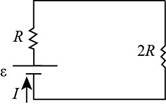
Four resistors are connected to a battery as shown in Figure P27.15. (a) Determine the potential difference across each resistor in terms of ε. (b) Determine the current in each resistor in terms of I. (c) What If? If R3 is increased, explain what happens to the current in each of the resistors. (d) In the limit that R3 → ∞, what are the new values of the current in each resistor in terms of I, the original current in the battery?
Figure P27.15

(a)
Answer to Problem 28.16P
Explanation of Solution
The resistors

Figure (1)
Formula to calculate the resistance across the circuit when resistors
Here,
Substitute
Thus, the resistance across the circuit when resistors
The resistors

Figure (2)
Formula to calculate the resistance when the resistors are connected in parallel is,
Here,
Substitute
Thus, the value of the resistance when the resistors are connected in parallel is
The resistors

Figure (3)
Formula to calculate the equivalent resistance across the circuit is,
Here,
Substitute
Thus, the equivalent resistance across the circuit is
The equivalent resistance is shown in the figure 4.

Figure (4)
Formula to calculate the current across the circuit is,
Here,
Substitute
Thus, the current across the circuit is
Formula to calculate the voltage across the
Here,
Substitute
Thus, the voltage across the
Thus, the voltage across the
Formula to calculate the voltage across the
Here,
Substitute
Thus, the voltage across the
Formula to calculate the current across the
Here,
Substitute
Thus, the current across the
Formula to calculate the current across the
Here,
Substitute
Thus, the current across the
Formula to calculate the voltage across the
Here,
Substitute
Thus, the voltage across the
Formula to calculate the voltage across the
Here,
Substitute
Thus, the voltage across the
Conclusion:
Therefore, the potential difference across
(b)
Answer to Problem 28.16P
Explanation of Solution
Formula to calculate the value of
Substitute
Thus, the value of
Formula to calculate the current across the
Here,
Substitute
Substitute
Thus, the current across the
Formula to calculate the current across the
Here,
Substitute
Substitute
Thus, the current across the
Formula to calculate the current across the
Here,
Substitute
Substitute
Thus, the current across the
Formula to calculate the current across the
Here,
Substitute
Substitute
Thus, the current across the
Conclusion:
Therefore, the current across
(c)
Answer to Problem 28.16P
Explanation of Solution
If the value of the
Since, the current remains same in series combination. So, the value of current across
If the value of the
Thus, the current across the
Conclusion:
Therefore, the value of current across
(d)
Answer to Problem 28.16P
Explanation of Solution
If
Here,
The resistors
Formula to calculate the resistance across the circuit when resistors
Here,
Substitute
Thus, the resistance across the circuit when resistors
From equation (11), the value of
From equation (12), formula to calculate the current across the
Here,
Substitute
Thus, the current across the
As the resistors
Here,
Thus, the original current in the battery is
Conclusion:
Therefore, the current across
Want to see more full solutions like this?
Chapter 28 Solutions
EBK PHYSICS FOR SCIENTISTS AND ENGINEER
- Please solve this problem correctly please and be sure to provide explanation on each step so I can understand what's been done thank you. (preferrably type out everything)arrow_forwardUse a calculation to determine how far the fishing boat is from the water level .Determine distance Yarrow_forwardNo chatgpt pls will upvote Already got wrong chatgpt answerarrow_forward
- 2. 1. Tube Rating Charts Name: Directions: For the given information state if the technique is safe or unsafe and why. 60 Hertz Stator Operation Effective Focal Spot Size- 0.6 mm Peak Kilovolts MA 2 150 140 130 120 110 100 90 80 70 2501 60 50 40 30 .01 .02 .04.06 .1 .2 .4.6 1 8 10 Maximum Exposure Time In Seconds Is an exposure of 80 kVp, 0.1 second and 200 mA within the limits of the single phase, 0.6 mm focal spot tube rating chart above? Is an exposure of 100 kVp, 0.9 second and 150 mA within the limits of the single phase, 0.6 mm focal spot tube rating chart above?arrow_forwardQ: You have a CO2 laser resonator (λ = 10.6 μm). It has two curved mirrors with R₁=10m, R2= 8m, and mirror separation /= 5m. Find: R2-10 m tl Z-O 12 R1-8 m 1. Confocal parameter. b= 21w2/2 =√1 (R1-1)(R2-1)(R1+R2-21)/R1+R2-21) 2. Beam waist at t₁ & t2- 3. Waist radius (wo). 4. 5. The radius of the laser beam outside the resonator and about 0.5m from R₂- Divergence angle. 6. Radius of curvature for phase front on the mirrors R₁ & R2-arrow_forwardNo chatgpt pls will upvotearrow_forward
 Physics for Scientists and EngineersPhysicsISBN:9781337553278Author:Raymond A. Serway, John W. JewettPublisher:Cengage Learning
Physics for Scientists and EngineersPhysicsISBN:9781337553278Author:Raymond A. Serway, John W. JewettPublisher:Cengage Learning Physics for Scientists and Engineers with Modern ...PhysicsISBN:9781337553292Author:Raymond A. Serway, John W. JewettPublisher:Cengage Learning
Physics for Scientists and Engineers with Modern ...PhysicsISBN:9781337553292Author:Raymond A. Serway, John W. JewettPublisher:Cengage Learning Principles of Physics: A Calculus-Based TextPhysicsISBN:9781133104261Author:Raymond A. Serway, John W. JewettPublisher:Cengage Learning
Principles of Physics: A Calculus-Based TextPhysicsISBN:9781133104261Author:Raymond A. Serway, John W. JewettPublisher:Cengage Learning Physics for Scientists and Engineers, Technology ...PhysicsISBN:9781305116399Author:Raymond A. Serway, John W. JewettPublisher:Cengage Learning
Physics for Scientists and Engineers, Technology ...PhysicsISBN:9781305116399Author:Raymond A. Serway, John W. JewettPublisher:Cengage Learning
 Physics for Scientists and Engineers: Foundations...PhysicsISBN:9781133939146Author:Katz, Debora M.Publisher:Cengage Learning
Physics for Scientists and Engineers: Foundations...PhysicsISBN:9781133939146Author:Katz, Debora M.Publisher:Cengage Learning





